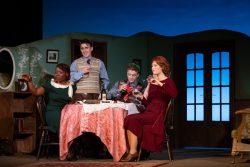 THE celebrations held to mark the anniversary of VE day must not only have stirred memories for those now comparatively few people who remember the occasion, but intrigued those who are too young to know about the lives and times of their parents and grandparents.
THE celebrations held to mark the anniversary of VE day must not only have stirred memories for those now comparatively few people who remember the occasion, but intrigued those who are too young to know about the lives and times of their parents and grandparents.
If you, like me, were born after the war, but while its destruction was still visible in bomb sites and its deprivations real in terms of rationing and widowed relatives, friends and neighbours, the staging of Noel Coward’s 1939 play This Happy Breed by the graduating students at AUB, was a timely reminder.
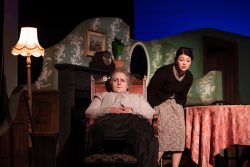 Named from John of Gaunt’s This Sceptered Isle speech from Shakespeare’s play Richard II, Coward’s saga of the Gibbons family from the end of the Great War to the eve of World War II was not staged until 1942, when that “impossible” war had been going for almost three years. It’s easy to imagine that in these days it would have been a six (or more) part television drama rather than a multi-scened stage play.
Named from John of Gaunt’s This Sceptered Isle speech from Shakespeare’s play Richard II, Coward’s saga of the Gibbons family from the end of the Great War to the eve of World War II was not staged until 1942, when that “impossible” war had been going for almost three years. It’s easy to imagine that in these days it would have been a six (or more) part television drama rather than a multi-scened stage play.
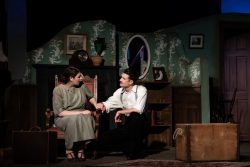 These student actors from Arts University Bournemouth, who will have been born more than 50 years after VE Day, were led by guest director Sean Aita into the world of the 1930s. Once again the AUB costume department did a wonderful job, dressing the actors authentically in period, and they in turn moved as though the clock had turned back.
These student actors from Arts University Bournemouth, who will have been born more than 50 years after VE Day, were led by guest director Sean Aita into the world of the 1930s. Once again the AUB costume department did a wonderful job, dressing the actors authentically in period, and they in turn moved as though the clock had turned back.
The reality of the time is brought out by Coward’s prophetic but determinedly hopeful tale of an ordinary family, with all its stresses, passions, jokes, jealousies and carefully-honed rules and expectations. At the same time as The Master was performing in stylised high-society comedies like Present Laughter, he was creating the Gibbons family, whose lives far more reflected his own upbringing than did the world of Amanda and Elyot and Gary and even Madame Arcati.
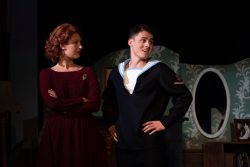 There wasn’t a false note among the 12-strong cast, led remarkably by Daniel Hancock as the “head of the family” Frank. Tall and rangy, he convincingly ages over the 20 years of the play from 1919. Olivia Ellen as his mother in law Mrs Flint, is a recognisably difficult old woman, and she and Daisy Fairy as Franks’s bereaved sister, the hypochondriac Sylvia, provide most of the comedy moments. It’s only when, towards the end, Sylvia begins spouting “her truth” in the doctrine of Christian Science, that it all becomes very currently and recognisably frightening.
There wasn’t a false note among the 12-strong cast, led remarkably by Daniel Hancock as the “head of the family” Frank. Tall and rangy, he convincingly ages over the 20 years of the play from 1919. Olivia Ellen as his mother in law Mrs Flint, is a recognisably difficult old woman, and she and Daisy Fairy as Franks’s bereaved sister, the hypochondriac Sylvia, provide most of the comedy moments. It’s only when, towards the end, Sylvia begins spouting “her truth” in the doctrine of Christian Science, that it all becomes very currently and recognisably frightening.
Amber Tormey holds the Gibbons family together as the long-suffering Ethel, with her three children, the sensible Vi (Lottie Surman), the ambitious and passionate Queenie (Fleur Manning) and headstrong Reg (Harry Bell). Oscar Vas is 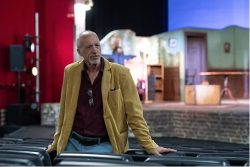 the loyal and love-struck Billy, with Ethan Clark as his Brummie father Bob, James Joslin as the mellowing firebrand Sam and Esther Kalala as Queenie’s friend and Reg’s wife Phyllis.
the loyal and love-struck Billy, with Ethan Clark as his Brummie father Bob, James Joslin as the mellowing firebrand Sam and Esther Kalala as Queenie’s friend and Reg’s wife Phyllis.
Sean Aita (pictured left against the set) directed with a fine eye for detail. The 1930s style set, complete with its big brown furniture, central fireplace, clever stairs and front door, was designed by the students. The set and production designer was Stanley Runyeard, with costumes designed by Katie Fealy assistedf by Lula Hedger. The hair and makeup supervisor was Ellie Rose.Every prop and every costume made its own contribution to the atmosphere of the piece. It could not have been more convincing. You could almost smell the mothballs and lavender.
GP-W